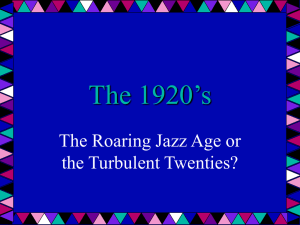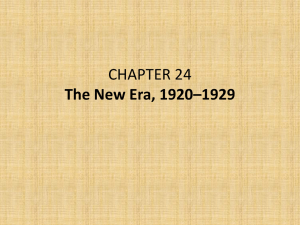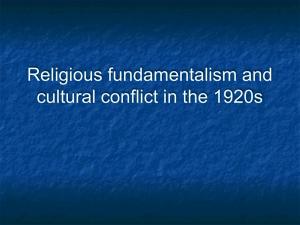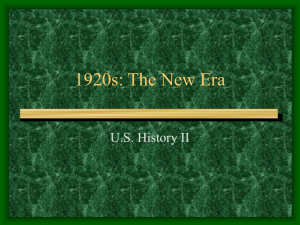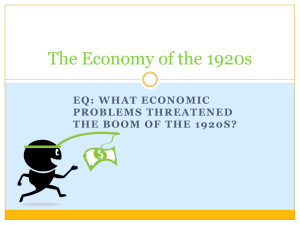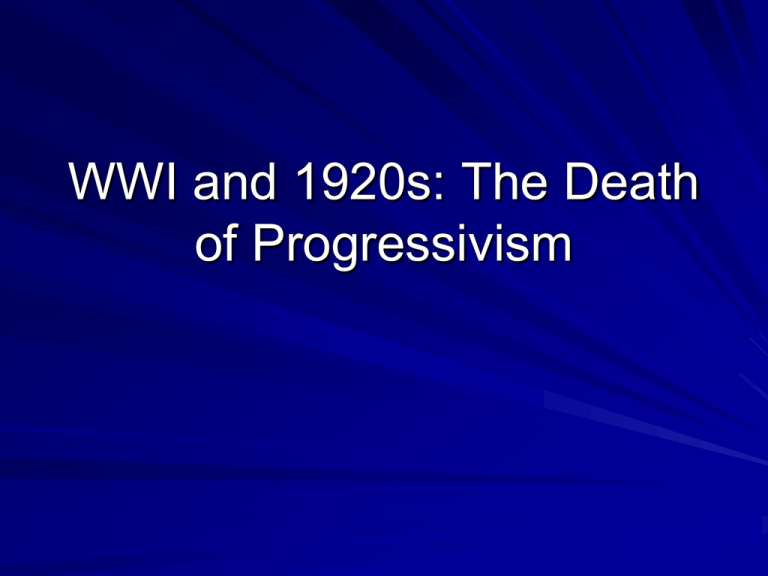
WWI and 1920s: The Death
of Progressivism
Benjamin M. Friedman, The Moral
Consequences of Economic Growth (2005)
White middle-class basically conservative
Economic prosperity willingness to expand
power/rights
– Prosperity 1900s-1917 Progressives
Economic hardship defend what little left
– Hardships 1890s rise Jim Crow, Populists
Exception: 1930s
I. “Fatal to Our Form of Government and
American Ideals”: WWI on the Home Front
A. War Capitalism
Mobilization unprecedented
involvement
Food Administration (produce +
conserve); Fuel Administration
(coal/gas) shortages at home
(inflation/black market)
War Industries Board:
purchases, allocated, set prices
(all on business advice huge
profits)
National War Labor Board
mediates + AFL
cooperates few strikes
Enough for men/ material in
Europe + full employment
(but cost living up)
Race riots [Chicago, July
27-Aug 2, 1919: “Negro
invasion” (38 d, 537 I; East
St. Louis, May, June 1917,
40-200 killed]
Total # women work not
grow much change type
of job
– 1,000s volunteer war effort +
Alice Paul and National
Woman’s Party
embarrassment passage
19th
Paid for 1/3 in taxes; 2/3 bonds/loans debt
$1B (1914) $25B (1919)
$33.5B cost; interest + vet benefits 3x (Bonus
Army)
B. War Democracy
“Once lead this people into war
and they’ll forget there ever
was a thing as tolerance. To
fight you must be brutal and
ruthless, and the spirit of
ruthless brutality will enter into
the very fibre of our national
life, infecting Congress, the
courts, the policeman on the
beat, the man in the street.”
Woodrow Wilson
April 1917
Wilson silence dissent
Committee on Public Information
(CPI)
CPI sought mind mobilization w/
propaganda:
Demonized Germany
Urged self-censorship & spied on
neighbors
Vigilantes harassed GermanAmericans
State/ local governments,
businesses, & colleges fired
dissenters, banned German
culture (sauerkraut liberty
cabbage)
Espionage Act (1917) banned
treasonous (loosely defined)
material from mail
Sedition Act (1918) banned
criticism of USG
– FBI to enforce J. Edgar Hoover
USG crushed IWW, imprison
Eugene V. Debs (socialist)
Schenck v. U.S. (1919): “clear and
present danger”
American Civil Liberties Union
Post-war: 4 million workers strike
(delayed demands) + growing
black militancy (DuBois, vets) +
Bolshevik Rev. (W sent troops)
“Red” summer Red Scare
(A. Mitchell) Palmer Raids
Post-War Depression
1920-21: post-war dislocations 24% fall
GDP
Relatively quick recovery
Shaped attitudes Americans + Hoover in
1929
– 1929 GDP falls only 12%, short recovery
before collapse
II. The New Era of the 1920s
Consumerism flourished b/c of advertising,
credit, & economic growth (compare 1990s)
Gov. fostered business growth (lobbyists)
– Coolidge: “The chief business of the American
people is business.”
– Taft court abandoned Progressive era rulings
+ attacked unions
Mass entertainment grew further as big
business, technology (radio), and middle class
expanded
Accelerated pop shifts (blacks, suburbs)
Some opposed modern changes (reactionary)
Decade ended w/ economic collapse
III. Economy
A. The Boom
Cost of living stable, earnings increased
Productivity gains: moving assembly line (1914),
electrification (1929, electricity in 2/3 of all homes)
“Welfare capitalism”
Car industry:
– 1900: 4,000 cars/year
– 1929: 4.8 million/year 1car/5 people (1/43 in UK)
As RxR: fuels other segments (steel, glass, oil,
construction), creates new biz (fast food, gas
stations), changes patterns (suburbs, roads)
Car symbol of social equality
B. Bust
1) Small business: corporate expansion
(gov’t support/acquiescence) crushed
– 1918: 29,000 chain stores; 1929: 160,000 (i.e.
WalMart)
2) Farmers: WWI produce for Europe
overproduction price crash (Dust Bowl)
3) Workers: union decline (WWI + Red
Scare), wages not keeping pace
– 1929 (pre-Crash): $2500/yr family 4 decent
living
– 2/3 tax paying Americans made less than
$1500
IV. Society
A. “Bound for the Promised Land”: Great
Migration
Blacks pulled North by WWI jobs ($48/day in
factories vs. $2/day; paid cash vs.
sharecropping), rights (blacks can vote de
facto + de jure), and power (substantial
voting blocs in cities limited by machine
patronage system/gerrymandering/white
flight)
1.5 million left South, 1920s
Harlem Renaissance (NYC): explosion
artistic expression [Langston Hughes,
James Weldon Johnson (writer + NAACP),
Alain Locke (The New Negro)]
Continued discrimination/violence
Marcus Garvey (Universal Negro
Improvement Assoc.) + call for black
independence/separation
– Black Star Line: “return” blacks to
“motherland” of Africa
B. Women Working
Number in workforce continued to increase postWWI
10.8 million working women (1930)
Job segregation (clerical); pay discrimination
Most female workers single
3.1 million wives worked to help w/ consumption
– 1920: 23% female workers; 1930: 29%
Many African, Japanese, & Mexican American
wives worked to help their families survive
– Worked as domestics or rural laborers
C. Suburbanization
Prosperity & cars fueled suburban expansion (can
+ want)
1930 almost 1 out of 6 in suburbs; growing 2x
speed cities
Middle & upper classes fled urban problems (white
flight)
– Left behind worse off: jobs, capital, talent gone gov’t
turns back on center cities
– Excluded blacks, Jews, Catholics, Hispanics (restrictive
covenants)
Cities & suburbs = centers of consumer culture
– Shopping centers, fast food
D. Children and The Elderly
Decrease # children: 1870-80 over half Am
women 5+; 1920s 20% 5+ more time +
resources for children
Better nutrition/ sanitation increased life
expectancy for most, but not all people
– 60 years by 1930 from 54 years in 1920
More people living past age 60 and forced
retirements increased poverty among elderly
US leaders rejected European-style pensions as
socialistic
Many states in 1920s adopted pensions &
retirement homes to reduce elderly poverty
V. Culture
A. Youth Culture: Sex, Drugs, Jazz
Radios homogenization culture
Advertising: selling image, creates insecurity + fear (“A
woman is only as old as her complexion”) culture of
consumption (rejection thrift + work; buy on credit)
Cars: suburbs, end rural isolation, youthful freedom
Movies: explosion # films + viewers; no censorship
changing attitudes sex
Women’s roles: voting (more right than actually), clothing
= Youth culture: generational chasm: youth embrace
change, elders fear parents irrelevant as model
Dating
Victorian expectation marriage broken
1910s: minority engaged premarital sex
1920s: majority in 1930
Limits sexual rev.: limited to eventual
husband or one other
1) spread of birth control, 2)
economic/cultural (industrial consumer),
3) Sigmund Freud
Drugs and Rock and Roll
Smoking: tobacco companies begin to
target women (weight control)
Drinking: despite (because of?)
Prohibition: majority college students
“smart” thing to do
Jazz: embrace black music (sexuality,
drugs): “primitive” rhythms appealed to
instincts mid class whites trying to control
– Jazz + forms of dancing banned from schools
B. Images of Femininity
“Flappers” remade image of femininity
Stressed personal freedom & sexuality
– Few actually became flappers
Dress styles changed: 19.5 yards of cloth to 7
Some women asserted independence/ equality:
Equal Rights Amendment (“Men and women shall
have equal rights throughout the United States
and every place subject to its jurisdiction.”); run
for office and form political organizations (League
of Women Voters)
– 19th did not dramatically change women’s
voting habits
C. The Gay ’20s
Homosexual culture more overt in
some cities (Greenwich Village,
NYC); greater freedom in
speakeasies illicit behaviors
overlap (provide entertainment)
degree protection; still
discrimination
No sharp line: So long as man
maintained “male” role in sex and
did not take on the “female” role,
he could cross back and forth
– “On the down low”


